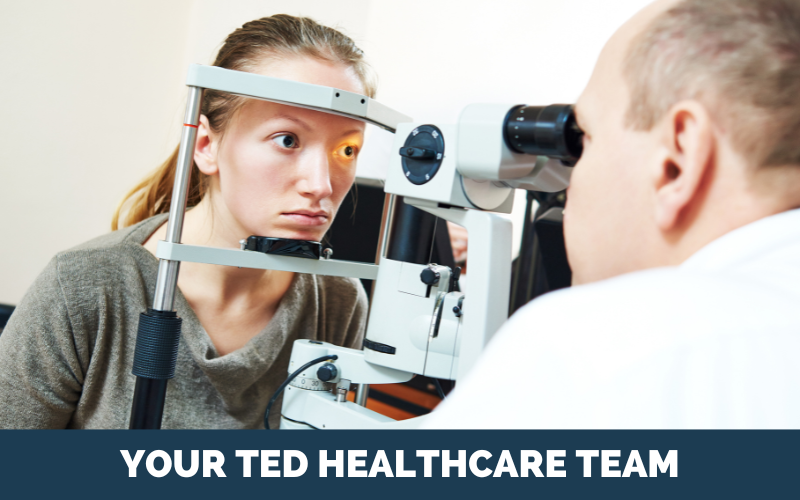Thyroid Eye Disease
About thyroid eye disease (TED)
Symptoms, causes and diagnosis
What is thyroid eye disease? Who gets it? What are the symptoms and how is it different to other thyroid and eye conditions? We share all you need to know.
Thyroid eye disease (TED) is an autoimmune disease that causes inflammation and damage to the fatty tissues, connective tissues and muscles around the eyes. It usually affects both eyes but can affect just one.
Autoimmune diseases occur when the immune system starts attacking healthy cells instead of targeting foreign bodies like bacteria and viruses. The type of cells it attacks determines the type of autoimmune disease that develops. For example, in rheumatoid arthritis (RA), it attacks the lining of the joints while in the case of TED, it attacks the fatty tissue and muscles behind the eyes.
While inflammation from TED can occur above and below the eyes, inflammation behind the eyes can push them forward, giving them a bulging appearance. This typically occurs during the active phase of the disease process. It may also cause the eyes to become red. TED affects everyone’s eyes differently though, for example, eye pain, misaligned eyes, light sensitivity and double vision.
Changes in the eyes can be observed at any time. TED is generally mild and may resolve itself over time. TED progresses through an active and inflammatory stage lasting approximately six months to three years. During this stage, symptoms can come and go.
Once symptoms stabilise or stop, TED eye specialists may determine that the disease has progressed to the inactive or chronic phase. In this phase, some people may not experience any symptoms, however, that does not mean the disease has gone away. Also, some people may need treatment for damage caused by prolonged inflammation, such as scarring or fibrosis.
It is believed that the thyroid gland secretes an excess amount of thyroid hormone (TH), which in turn increases the stimulation of thyroid-stimulating hormone receptor (TSHR) that is primarily found in the thyroid gland. TSHR is also found in other tissues in the body, such as the eyes. While rare, it can be diagnosed in patients with normal thyroid function.
The exact prevalence of TED in Australia is unknown. However, a 2022 US study reported that TED is generally more common in women than men, with 16 cases per 100,000 females, compared to 2.9 cases per 100,000 males.1 Severe TED is more common in males, with a ratio of 4:15. TED can also be diagnosed in children, with 1.7 to 3.5 cases per 100,000.
TED is not contagious so it can’t be transmitted. There is currently no cure for TED, but symptoms such as pain and inflammation can be well-managed. In Australia, a game-changing targeted medicine could be available as soon as next year.
Other names for TED
While thyroid eye disease is often associated with Graves’ disease, it is important to realise that they are two separate diseases and require different treatments. Other names for TED frequently include words like “Graves’” and “thyroid”, such as:
- Graves’ eye disease
- Graves’ ophthalmopathy
- Graves’ orbitopathy
- Thyroid-associated orbitopathy
- Thyroid ophthalmopathy
TED has no known specific cause, but several factors can play a role.
Genetics and other autoimmune conditions
Thyroid eye disease is not necessarily inherited but autoimmune diseases tend to run in families. Different family members may develop different autoimmune diseases. For example, the cousin of a member with TED could have RA, a grandparent could have type 1 diabetes or a sibling could have psoriasis. Also, anyone with an autoimmune disease has an increased risk of developing other autoimmune diseases.
Other risk factors for developing thyroid eye disease include:
- Cigarette smoking
- Uncontrolled thyroid disease
- Treatment with radioactive iodine treatment
- Advanced age
- Stress
- Poorly controlled diabetes2
Graves’ disease
Graves’ disease is a separate autoimmune disease, but it is often linked with TED. Roughly 30 to 40 per cent of people with Graves’ experience signs and/or symptoms of TED3 while around 90 per cent of people with TED have Graves’ disease.2
In Graves’ disease, immune cells attack the thyroid gland (located in the neck). This gland produces hormones that affect many organs in the body. Graves’ disease is a common cause of hyperthyroidism (an excess production of hormones) so it can also affect the organs.
Common symptoms of Graves’ disease include:
- Weight loss, despite increased appetite
- Nervousness, irritability, trouble sleeping, fatigue
- Frequent bowel movements
- An enlarged thyroid gland
- Rapid or irregular heartbeat
Hashimoto’s disease
Hashimoto’s disease is also an autoimmune disease that affects the thyroid gland; however, it can lead to the underproduction of thyroid hormones (hypothyroidism). Up to 6 per cent of people with Hashimoto’s may develop thyroid eye disease.4
Common symptoms of Hashimoto’s disease include:
- Weight gain
- Fatigue
- Sensitivity to the cold
- Constipation
- Muscle pain
- Dry skin, thin hair and/or brittle nails
TED symptoms can vary from person to person and depend on the severity of the condition. Some people have bulging eyes; others can have pain behind the eyes and pain with eye movements. It is possible to experience several symptoms of TED at the same time and at various degrees of severity.
Common symptoms of TED to watch for include:
Bulging eyes (proptosis)
The most noticeable symptom of TED is bulging eyes and people with TED are the most likely to experience this symptom. Inflammation of the fat and tissue behind the eyes pushes them forward from their eye sockets. The whites of the eyes become more visible. Bulging eyes are often unsightly and embarrassing.5
Eye pain or eye pressure
Pain may be felt in, around and behind the eyes due to inflammation and irritation. It can affect the movement of the eyes when looking up, down or sideways. There may also be a feeling of pressure behind or around the eyes that could lead to headaches.
Retracted eyelids
Pulled-back eyelids are mostly associated with TED. It is usually the upper eyelid that retracts, although the lower lid may also be affected. Retracted eyelids can cause a constant stare or wide-eyed appearance. In some cases, it might be essential to tape shut the eyes to sleep. Pulled-back eyelids may lead to dry, irritated or even infected eyes. Like bulging eyes, it can also affect self-esteem and quality of life.6
Dry, gritty eyes
Dry eyes can be the symptom of many conditions, including autoimmune diseases. We need layers of tears to protect and cover our eyes. However, sometimes we don’t produce enough tears or they evaporate too quickly (or both). Your eyes might feel dry or sandy, as though there is something in your eye. This can also make your eyes feel itchy or irritated.7
Watery, teary eyes (epiphora)
Epiphora also has many different causes, occurring when we produce too many tears or they don’t drain properly. In some cases, they are an overresponse to dry eyes. Excess fluid in the eyes can make it harder to see clearly.8
Puffy eyes or eyelids (periorbital oedema)
Peripheral oedema occurs when the body is unable to remove fluid from parts of the body. Periorbital oedema is when fluid collects around the eyes. It can be due to allergies or an infection but is also a common symptom of TED.9
Inflamed eyelids (blepharitis)
With blepharitis, the edges of the eyelids become red or dark and become swollen and scaly. It can be caused by various conditions, including allergies, dandruff or dry or irritated eyes.10
Red eyes or eyelids or bloodshot eyes
These inflammatory symptoms are commonly associated with allergies or an infection but can also be caused by TED.
Light sensitivity (photophobia)
The eyes may become extra sensitive to bright light. This is often a result of an irregular, dry eye surface that can cause light to scatter in many directions and can cause discomfort. It may also be called photophobia. While this literally means “fear of light”, in medical terms it means the uncomfortable or painful experience of being in bright light.11
Blurry vision
Blurry vision has many causes. In TED, it is generally due to damage to the thin, clear layer of the front of the eye (cornea) or swollen tissues and muscles behind the eye squeezing the optic nerve.12
Misaligned or crossed eyes (strabismus)
Inflammation of the eye muscles can cause them to become thicker and more fibrous, often restricting movement and affecting eye alignment. Misaligned or crossed eyes can cause blurry or double vision. These symptoms can be temporary, situational or constant. They can be corrected if treated early and may be managed with corrective glasses.12
Vision loss
People with severe TED may experience vision loss due to damage to the optic nerve. Optic nerve dysfunction caused by TED is referred to as dysthyroid optic neuropathy (DON). Colours may become dull or washed out or parts of vision may disappear. If left untreated, these symptoms may worsen and become permanent so it is important to seek appropriate treatment early.12,13
Differences between thyroid eye disease and other eye conditions
TED can sometimes be difficult to diagnose, and patients may be incorrectly treated for other conditions such as allergy, hay fever or conjunctivitis.
The following signs may indicate TED rather than another eye condition.
- Symptoms may occur in the wrong season for hay fever.
- Allergies usually cause itchy eyes, whereas TED does not.
- Conjunctivitis usually causes sticky eyes, whereas TED usually does not.
- TED is often associated with an ache or pain in or behind the eye, especially when looking up or sideways, whereas the other conditions mentioned are not.
- TED is sometimes associated with double vision whereas the other causes of eye symptoms are not.
It is important to know that TED affects everyone differently and it can leave some people with ongoing symptoms like eye bulging, eye pain, double vision and pressure behind the eyes. Therefore, the earlier you notice your symptoms, the sooner your doctor can help. If you feel your symptoms have been dismissed, misdiagnosed or undertreated, seek a second opinion or ask for a referral to an ophthalmologist or endocrinologist.
TED cannot currently be diagnosed via a specific laboratory test or symptoms. Instead, doctors need to conduct several tests to help eliminate other possibilities and see what is happening within and around your eye. These can include:
- Thyroid function tests
- Blood tests for thyroid antibodies
- Computed tomography (CT) scans
- Magnetic resonance imaging (MRI) scans
Your doctor might also look for changes to your eye’s appearance (such as bulging eyes) and check your eye pressure. Thyroid eye disease can cause the pressure inside the eye to rise, which puts you at risk for glaucoma (a group of eye diseases that can damage your optic nerve and lead to vision loss). The doctor will also check the health of your optic nerve, which sends information from your eyes to your brain.
While thyroid eye disease is a physical condition, it often has a significant impact on mental health. Many people with TED experience anxiety, depression, and social isolation due to the visible and often stigmatised nature of the disease. However, there is no shame in seeking mental health support.
If you have friends or family you trust, it might help to tell them how much TED is affecting you mentally and ask for some moral support. You could also consider joining a TED or thyroid peer support group in person or online. Hearing from people with similar conditions can help you feel less alone, plus they may have great tips to help you manage your condition or daily activities more easily.
It is also a good idea to talk to your GP about your mental health. They can offer you some advice or refer you to a psychologist, psychiatrist, counsellor or another allied mental health professional.
If this content has raised feelings that concern you, you can contact:
- Lifeline: lifeline.org.au or call 13 11 14
- Beyond Blue: beyondblue.org.au or call 1300 22 4636
This information should never replace the information and advice from your treating doctors. It is meant to inform the discussion that you have with healthcare professionals, as well as others who play a role in your care and well-being.
1 Szelog J, Swanson H, Sniegowski MC, Lyon DB. Thyroid Eye Disease. Mo Med. 2022 Jul-Aug; 119(4):343-350. PMID: 36118816; PMCID: PMC9462910. https://www.ncbi.nlm.nih.gov/pmc/articles/PMC9462910/#b7-ms119_p0343
2 Kossier et al. Endocrine Society. Patient Resources. Thyroid Eye Disease. 2022 January 24. https://www.endocrine.org/patient-engagement/endocrine-library/thyroid-eye-disease
2 Mivision: First Australian Thyroid Eye Disease Clinic. 2023 May 1, https://mivision.com.au/2023/05/first-australian-thyroid-eye-disease-clinic/
4 Jamal I. Hashimoto’s Thyroiditis Associated Thyroid Eye Disease: A Success Story of Teprotumumab, Journal of the Endocrine Society, Volume 5, Issue Supplement_1, April-May 2021, Page A932, https://academic.oup.com/jes/article/5/Supplement_1/A932/6241103
5 Cleveland Clinic: Proptosis (Bulging Eyes). https://my.clevelandclinic.org/health/diseases/proptosis-bulging-eyes
6 Osaki TH, Monteiro LG, Osaki MH. Management of eyelid retraction related to thyroid eye disease. Taiwan Journal of Ophthalmology. 2022 Feb 14;12(1):12-21. doi: 10.4103/tjo.tjo_57_21. PMID: 35399960; PMCID: PMC8988987. https://www.ncbi.nlm.nih.gov/pmc/articles/PMC8988987/
7 Cleveland Clinic: Dry Eye. https://my.clevelandclinic.org/health/diseases/24479-dry-eye
8 Cleveland Clinic: Epiphora (Watery Eyes). https://my.clevelandclinic.org/health/diseases/17944-epiphora-watery-eyes
9 Royal Australian College of General Practitioners: Clinical Practice. Therapeutic review. Thyroid Orbitopathy. https://www.racgp.org.au/getattachment/e10a3bd8-a800-4a53-8635-1bf0764912d6/attachment.aspx
10 Cleveland Clinic: Blepharitis. https://my.clevelandclinic.org/health/diseases/10032-blepharitis
11 Thyroid Eye Disease: Sensitivity to Light. https://thyroideyedisease.net/light-sensitivity
12 Thyroid Eye Disease: Vision Changes. https://thyroideyedisease.net/vision-changes
13 EyeWiki: Dysthyroid Optic Neuropathy. https://eyewiki.org/Dysthyroid_Optic_Neuropathy
Further resources
Australian Thyroid Foundation: https://www.thyroidfoundation.org.au
Cleveland Clinic: Thyroid Eye Disease. https://my.clevelandclinic.org/health/diseases/17558-thyroid-eye-disease
Healthdirect Australia: Graves’ Disease. https://www.healthdirect.gov.au/graves-disease#:~:text=Graves’%20disease%20is%20an%20autoimmune,(an%20overactive%20thyroid%20gland)
Mayo Clinic: Hyperthyroidism (overactive thyroid), https://www.mayoclinic.org/diseases-conditions/hyperthyroidism/symptoms-causes/syc-20373659
Moleiro AF, et al. Tocilizumab as a Useful Tool for Thyroid Eye Disease in Pediatric Population: A Case Report. Case Rep Ophthalmol. 2022 Nov 17;13(3):877-884. doi: 10.1159/000526546. PMID: 36466065; PMCID: PMC9710467. https://www.ncbi.nlm.nih.gov/pmc/articles/PMC9710467
Queensland Eye Institute Foundation: https://qei.org.au/qei-foundation
Thyroid Eyes: Thyroid Eye Disease Phases. https://www.thyroideyes.com/about-thyroid-eye-disease/phases-of-ted#:~:text=Thyroid%20Eye%20Disease%20may%20slow,your%20condition%20has%20gone%20away




